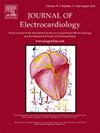A systematic review and meta-analysis on the performance of convolutional neural networks ECGs in the diagnosis of hypertrophic cardiomyopathy
IF 1.3
4区 医学
Q3 CARDIAC & CARDIOVASCULAR SYSTEMS
引用次数: 0
Abstract
Introduction
Hypertrophic cardiomyopathy (HCM) is a leading cause of sudden cardiac death in younger individuals. Accurate diagnosis is crucial for management and improving patient outcomes. The application of convolutional Neural Networks (CNN), a type of AI modeling, to electrocardiogram (ECG) analysis, presents a promising and optimistic avenue for the detection of HCM. We conducted a meta-analysis to assess the effectiveness of CNN models in diagnosing HCM through ECG.
Methods
MEDLINE, Embase, and Cochrane were searched up to August 12, 2024, focusing on CNN ECG-based HCM detection models. The outcomes were sensitivity, specificity, and SROC. Pooled proportions were calculated using a random-effects model with 95 % confidence intervals (CIs), and heterogeneity was assessed using the I2 statistics. This study was registered on PROSPERO protocol CRD42024581925.
Results
Our analysis included 16 studies with ECG data from 513,972 patients. The AI algorithms employed CNNs for ECG interpretation. Sixteen studies contributed to the qualitative analysis, while seven studies for the pooled SROC with an 11 % false positive rate, with a sensitivity of 89 % (95 % CI 86–92 %) and a specificity of 88 % (95 % CI 81–93 %).
Conclusion
AI-driven ECG interpretation shows high accuracy and sensitivity in detecting HCM, though the modest PPV suggests that AI should be integrated with clinical evaluation to enhance reliability, particularly in screening settings.
关于卷积神经网络心电图在肥厚性心肌病诊断中的表现的系统回顾和荟萃分析
肥厚性心肌病(HCM)是年轻人心源性猝死的主要原因。准确的诊断对于管理和改善患者预后至关重要。卷积神经网络(CNN)是一种人工智能建模,将其应用于心电图(ECG)分析,为HCM的检测提供了一条有前途和乐观的途径。我们进行了一项荟萃分析,以评估CNN模型通过ECG诊断HCM的有效性。方法检索截至2024年8月12日的medline、Embase和Cochrane,重点检索基于CNN脑电图的HCM检测模型。结果为敏感性、特异性和SROC。采用95%置信区间(ci)的随机效应模型计算合并比例,采用I2统计量评估异质性。本研究已通过PROSPERO协议CRD42024581925注册。结果我们的分析包括16项研究,513972例患者的心电图数据。人工智能算法采用cnn进行心电解释。16项研究对定性分析做出了贡献,而7项研究对合并SROC进行了分析,假阳性率为11%,敏感性为89% (95% CI 86 - 92%),特异性为88% (95% CI 81 - 93%)。结论人工智能驱动的心电判读在检测HCM方面具有较高的准确性和敏感性,尽管适度的PPV表明人工智能应与临床评估相结合以提高可靠性,特别是在筛查环境中。
本文章由计算机程序翻译,如有差异,请以英文原文为准。
求助全文
约1分钟内获得全文
求助全文
来源期刊

Journal of electrocardiology
医学-心血管系统
CiteScore
2.70
自引率
7.70%
发文量
152
审稿时长
38 days
期刊介绍:
The Journal of Electrocardiology is devoted exclusively to clinical and experimental studies of the electrical activities of the heart. It seeks to contribute significantly to the accuracy of diagnosis and prognosis and the effective treatment, prevention, or delay of heart disease. Editorial contents include electrocardiography, vectorcardiography, arrhythmias, membrane action potential, cardiac pacing, monitoring defibrillation, instrumentation, drug effects, and computer applications.
 求助内容:
求助内容: 应助结果提醒方式:
应助结果提醒方式:


